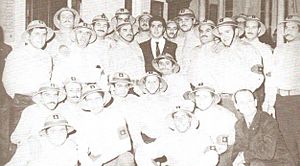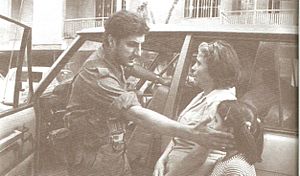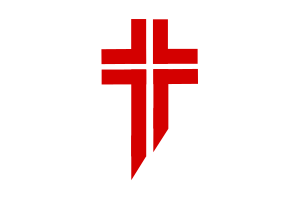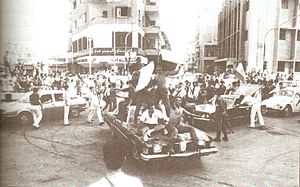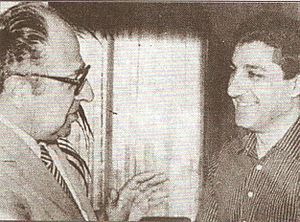Bachir Gemayel facts for kids
Quick facts for kids
Bachir Gemayel
بشير الجميّل |
|
|---|---|
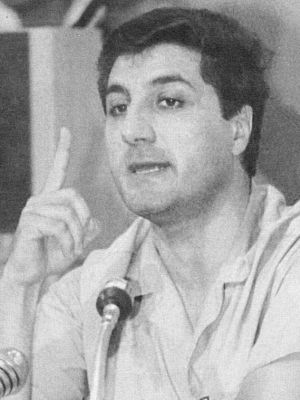 |
|
| 7th President of Lebanon | |
|
Elect
|
|
| In role 23 August 1982 – 14 September 1982 |
|
| Prime Minister | Shafik Wazzan |
| Preceded by | Élias Sarkis |
| Succeeded by | Amine Gemayel |
| Commander of the Lebanese Forces | |
| In office 18 January 1976 – 14 September 1982 |
|
| Preceded by | Office established |
| Succeeded by | Fadi Frem |
| Personal details | |
| Born | 10 November 1947 Achrafieh, Beirut, Lebanon |
| Died | 14 September 1982 (aged 34) Achrafieh, Beirut, Lebanon |
| Political party | Kataeb Party |
| Spouse |
Solange Tutunji
(m. 1977) |
| Relations | Amine Gemayel (brother) |
| Children | Maya Gemayel (1978–1980) Youmna Gemayel Nadim Gemayel |
| Parents | Pierre Gemayel Geneviève Gemayel |
| Education | Saint Joseph University |
| Occupation | Lawyer |
Bachir Pierre Gemayel (Arabic: بشير بيار الجميّل; born 10 November 1947 – died 14 September 1982) was a Lebanese leader. He was a commander of a group called the Lebanese Forces. This group was the military part of the Kataeb Party during the Lebanese Civil War.
In 1982, he was chosen to be the President of Lebanon. However, he was killed by a bomb before he could officially start his job. This happened on September 14, 1982. The bomb was set off by Habib Shartouni, who was part of the Syrian Social Nationalist Party.
Bachir Gemayel is a very important and sometimes debated person in Lebanon's history. Many Christians see him as a hero. But others criticize him for his actions during the war and his connections with Israel.
Contents
Early Life and Family Background
Bachir Gemayel was born in Achrafieh, a neighborhood in Beirut, Lebanon, on November 10, 1947. He was the youngest of six children. His family, the Gemayels, came from a village called Bikfaya. They are one of the most important Christian families in Lebanon.
His father, Pierre Gemayel, started the Kataeb Party (also known as the Phalange party) in 1936. Bachir went to school at Collège Notre Dame de Jamhour and Institution Moderne du Liban. He later studied at St. Joseph University in Beirut. He earned degrees in law in 1971 and political science in 1973. In 1971, he also studied in the United States. After finishing his studies, he became a lawyer in 1972.
The Gemayel Family's Role in Lebanon
Bachir's father, Pierre Gemayel, founded the Kataeb Party after studying in Europe. This party grew to have many members. Pierre Gemayel was a Lebanese minister and a powerful figure until he died in 1984.
After Bachir's death, his brother, Amine Gemayel, was elected president in 1982. He served until 1988. Many other members of the Gemayel family also became members of the Lebanese parliament. These include Bachir's wife, Solange Gemayel, and his son, Nadim Gemayel. His nephews, Sami Gemayel and Pierre Amine Gemayel, also served in parliament. Pierre Amine Gemayel was even a minister before he was assassinated in 2006.
Joining the Kataeb Party
Bachir Gemayel joined the youth section of the Kataeb Party when he was 12 years old. He spent a lot of time with the party's organized political group. He was also the president of the Kataeb student group at St. Joseph University from 1965 to 1971.
In the late 1960s, he received military training in Bikfaya. He became a leader of a militia unit in the Kataeb Regulatory Forces (KRF). This was the party's military group, formed in 1961. In the early 1970s, he created the "Bikfaya Squad" within the KRF. Here, he learned the basics of military fighting.
After some clashes between the Lebanese Army and the Palestine Liberation Organization (PLO) in 1968-69, Gemayel started training Christian students. This training happened at a Kataeb camp. This was the beginning of what would later become the Lebanese Forces. At this time, he was a junior militia commander under William Hawi, the head of the KRF.
In 1969, Palestinian fighters in Lebanon briefly kidnapped Gemayel. He was taken to a refugee camp and beaten. He was released hours later after Kamal Jumblatt, a government minister, helped.
Gemayel became a member and later the head of the "BG Squad" within the Kataeb Regulatory Forces. This group had 12 specially trained members, including Fouad Abou Nader and Elie Hobeika. They were known as fierce fighters. Gemayel had his own strong ideas and wanted to lead the "Lebanese Forces."
In 1976, Gemayel tried to resign from the Kataeb Party, but his resignation was not accepted. He was strongly against the Syrian Army entering Lebanon. He believed Syria wanted to take over Lebanon, as Syrian officials often said Lebanon was part of Syria.
Leading the Military Forces
Fighting the PLO
In 1975, Gemayel was accused of being responsible for the Black Saturday event. This was a violent day where many Palestinians and Lebanese Muslims were killed.
Christian East Beirut was surrounded by Palestinian camps. Kidnappings and attacks on Lebanese civilians happened daily. This led Christian militias, including the Kataeb Forces, to attack these camps. On January 18, 1976, Gemayel led the attack on the Karantina camp, where about 1,000 fighters and civilians died. In response, Palestinian forces attacked the Christian town of Damour, killing many Christian civilians.
Later that year, the Christian militias besieged the Tel al-Zaatar camp for 52 days. Gemayel played a key role in the final stages of this battle. His forces helped destroy the camp's ammunition storage, which led to its fall. Christian militias also fought the PLO in the Battle of the Hotels in central Beirut. Gemayel led the successful fight for the Holiday Inn hotel.
In 1976, after William Hawi was killed, Gemayel became the head of the Kataeb Regulatory Forces. He also became a main leader of the Lebanese Front. This was a group of Christian parties and their military branch, the Lebanese Forces (LF). The LF fought against both the PLO and the Syrian Army, which had entered Lebanon and became an occupying force.
Gemayel led his troops in the 'Hundred Days' War' in 1978. During this time, the Lebanese Forces successfully defended Eastern Beirut from Syrian attacks for about three months. This war led to the Syrian troops leaving East Beirut. Israel supported the Lebanese Front's militia during this time.
In 1981, the LF faced a major battle in Zahlé, the largest Christian town in the East. The LF, with help from the Lebanese Army, fought the Syrian forces. This battle was seen as a victory for the Lebanese cause and strengthened Bachir Gemayel's position.
Challenges within the Lebanese Front
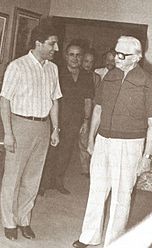
Even with their success, there were tensions within the Lebanese Front. In 1978, a tragic event known as the Ehden massacre occurred. Members of the Marada Brigade militia, led by Tony Frangieh, had killed some Phalangist members. Gemayel sent his men to Ehden to capture those responsible. However, Tony Frangieh was still there, and a fight broke out, leading to the deaths of Tony Frangieh and his family. Gemayel was upset by this, but he supported his men.
Gemayel's militia also had conflicts with the Tigers, another Christian militia. They argued over money and military supplies from Israel. In July 1980, Gemayel sent his troops to Safra, where the Tigers' leader, Dany Chamoun, was staying. This led to a violent clash where many Tigers were killed. Dany Chamoun escaped.
After these events, Gemayel worked to combine the different Christian militias into the Lebanese Forces, with himself as the commander. This was called the "Unification of the Christian Rifle." His brother Amine was against this at first, but their father, Pierre Gemayel, helped make it happen. This made Bachir the main leader of the Christian military side in the civil war.
Israeli Invasion and Election as President
In 1982, Israel invaded Lebanon. Israel's Defense Minister, Ariel Sharon, had met with Gemayel earlier. Sharon told him that Israel planned to remove the PLO from Lebanon. While Gemayel did not control Israel's actions, Israel's support for the Lebanese Forces made some Lebanese unhappy.
Gemayel met with a PLO representative and warned him that Israel would invade. He advised the PLO to leave Lebanon peacefully.
The PLO was forced out of Lebanon in August 1982. During the invasion, Israel wanted the Lebanese Forces to help fight the PLO in West Beirut. However, Gemayel refused, saying his forces would not help an invading army. By then, Gemayel had announced he wanted to be president. The United States supported him and sent peacekeeping troops to help the PLO leave. Gemayel asked them to stay longer to keep Lebanon stable, but they refused. Israel's intelligence agency, Mossad, also helped his election. On August 23, 1982, Bachir Gemayel was elected president.
On September 1, 1982, Gemayel met with Israeli Prime Minister Menachem Begin. Begin wanted Gemayel to sign a peace treaty with Israel once he became president. Gemayel refused to sign a treaty without agreement from all Lebanese people and Arab nations. This angered the Israelis, who felt Gemayel was moving away from them.
On September 12, 1982, Ariel Sharon met with Gemayel again. Gemayel told Sharon that the Lebanese Army would soon clear out any remaining fighters in Palestinian camps. They also agreed that the Lebanese Army, with Israeli help, would attack Syrian Army positions. Gemayel still refused to sign a peace treaty.
Gemayel had planned to use the Israeli army to push the Syrian Army out of Lebanon. Then, he hoped to use his connections with the Americans to make Israel leave Lebanon too.
Assassination
On September 14, 1982, Bachir Gemayel was giving a speech at his party's headquarters in Achrafieh. At 4:10 PM, a bomb exploded, killing Gemayel and 26 other politicians. For hours, no one knew if he was alive. His body was finally identified by his wedding ring and letters he carried. The next morning, it was confirmed that he had been killed. The U.S. Federal Bureau of Investigation (FBI) said the Syrian Social Nationalist Party (SSNP) was responsible.
Habib Shartouni, a member of the SSNP, was later arrested for the assassination. His sister lived in the apartment above where Gemayel was speaking. Shartouni had planted the bomb there the day before. He called his sister to tell her to leave the building, then set off the bomb remotely. He later confessed, saying he did it because he believed Gemayel had "sold the country to Israel." Shartouni was jailed for 8 years but was freed in 1990 when Syrian troops took control of Lebanon. Many people believe the Syrian government knew about the assassination and supported Shartouni.
Aftermath of the Assassination
Leaders from around the world, including U.S. President Ronald Reagan, condemned Gemayel's assassination. Reagan called him a "promising young leader."
Bachir Gemayel's older brother, Amine Gemayel, was elected president soon after, serving from 1982 to 1988. Amine was seen as more moderate than Bachir.
Many of Bachir Gemayel's supporters were not happy with Amine. This led to the Lebanese Forces becoming a separate political party from the Kataeb Party.
Sabra and Shatila Event
After Gemayel's assassination, a tragic event known as the Sabra and Shatila Massacre occurred. Many civilians, mostly Palestinians and Lebanese Shiites, were killed in retaliation for Gemayel's death.
Bachir Gemayel's Legacy
Some people thought Gemayel was too extreme for the presidency. Muslim and leftist leaders preferred a more moderate leader. George Hawi said in a documentary that he believed Gemayel would be assassinated once elected.
Some critics, like Deputy Nawaf al-Moussawi, said Gemayel reached the presidency "on the back of an Israeli tank." He is also criticized for using force against civilians and for his connections with Israel. However, most right-wing Christians see him as a patriotic leader who fought for Christian rights and for Lebanon's independence.
Personal Life
Bachir Gemayel was married to Solange Gemayel. They had three children. Their oldest daughter, Maya, was killed in 1980 at 18 months old by a car bomb meant for him. His second daughter, Youmna, was born in 1980. His son, Nadim, was born a few months before Bachir's death. Nadim later became a lawyer and was elected to the Lebanese Parliament in 2009.
See also
 In Spanish: Bashir Gemayel para niños
In Spanish: Bashir Gemayel para niños
- List of assassinated Lebanese politicians
- List of attacks in Lebanon
- Amine Gemayel
- Lebanese Civil War
- Lebanese Forces
- Kataeb Party
- Kataeb Regulatory Forces




